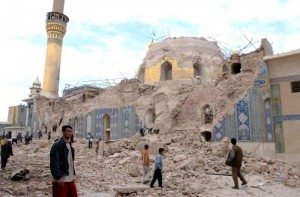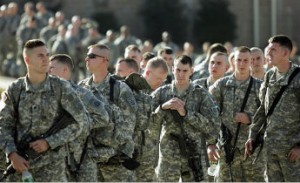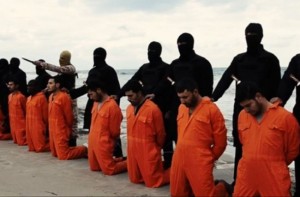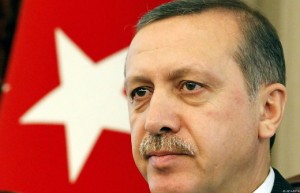Romancing the Sunni: A US Policy Tragedy in Three Acts. Act II
SPOTLIGHT, 4 Jan 2016
A Surge of Confusion
23 Dec 2015 – After the February 2006 Sunni bombing of the Samarra Golden Mosque, the US proved unable to hold back the tide of Shia retaliation. The UN estimated that, during 2006 alone, Shia death squads had slaughtered some 34,000 Sunni, many with exemplary cruelty.
Iraq’s Sunni leaders awakened to the reality that far from cowing the Shia while punishing the Americans they were now in danger of their very lives. They offered to stop killing Americans if the Americans could stop the Shia from killing them. The US government set about doing that. This was “the surge.”
Note well, however, that the US had offered the Sunni a similar deal in 2004. At that time, the Sunni still thought that they could beat both the Americans and the Shia. By 2006, they were begging for their lives.
But the US government, far from driving a hard bargain, chose to see their request for something approaching an alliance against the Shia as the “awakening” of the Sunni populations’ inner “moderation” and rushed to empower its leaders with money and weapons.
The US choice to neglect the massive fact that fear of the Shia had led the Sunni to stop fighting Americans fit all too well with the US foreign policy establishment’s perennial, ignorant, practice of categorizing foreigners as “moderates” or “extremists” (aka. good guys and bad guys). That practice eliminates the bother of learning what foreigners actually have in mind.
The US establishment’s reaction to the Sunni who shoot at Americans has been no different from what it was with regard to the Soviets, or what it is to the Chinese, Iranians, or anyone else: See, by being nicer to them we will help awaken their inner moderation. Putting fear in their hearts is counterproductive.
But putting effective sovereignty of territory, plus weapons and money, in the hands of Sunnis who had been killing Americans did not make them pro American, much less turn them into “moderates.” It simply gave them more power to be what they want to be. Our illusions to the contrary continue to cost us dearly.
Sunni-stan, Jihadis, and Daesh/ISIS
Unlike the Americans, neither the Sunni nor the Shia had any illusions about the other’s benevolence. By 2008 the government in Baghdad that had been created by “democracy” was more powerful and more Shia-sectarian than ever. As the end of American patronage loomed for Iraq’s Sunni population it leaned once again on traditional sources of support: the military remnants of Saddam’s Ba’athist regime, and foreign jihadis.
The Ba’athist-jihadi combination, which had functioned throughout the US occupation, was headquartered in Syria. There Bashar al Assad’s regime, Ba’athist as well as Alawite, supported the Sunni effort in Iraq out of Ba’athist solidarity. The results of Assad’s balancing act were tragic for Syria, redounded upon Iraq, and finished both polities’ destruction.
Assad’s help to Iraqi Sunnis had not lessened the hatred that Syrian Sunnis bear for his Alawite regime. Moreover, the Sunni Muslims from around the world who had come to and through Syria to fight in Iraq, ended up terribly disappointed that Iraq had ended up largely ruled by Shia, and turned their anger on Assad and on his Alawis.
So, in 2011, as the Americans were leaving Iraq, Sunni elements in Syria as well as in Iraq stepped up their fight for power in their own countries. They drew from most (but not all) of the same donors in the Persian Gulf who had fed their fight in Iraq and gained control on both sides of the border.
Having long since learned to disregard that border, it would have been surprising had they not coordinated and consolidated administration of the areas over which they ruled. The result was what can best be understood as a Sunni-stan, which stands naturally alongside Kurdistan whose capital is Erbil, and Baghdad’s Shia-stan.
This Sunni-stan’s main founding factions determined its character and relevance to America. Older, secular Baathists were technicians of power. They brought military expertise and the network of financial contributors who had sustained them through the long fight against the Americans.
Like the regime figures in the Gulf monarchies who financed them, they were not so interested in fighting the Americans — or even the Shia — as they were in doing whatever was necessary to establishing a Sunni homeland like Saddam’s Iraq. The young jihadists were not interested in good relations with the Sunni states, whose legitimacy they denied.
For them control of territory was simply a tool for worldwide jihad. They brought religious enthusiasm and attracted tens of thousands of Sunni recruits eager to kill infidels for Allah — Shia first, but anyone else as well. Whether they had come from Saudi Arabia or not, their theology was Wahhabi, the practical essence of which is license to declare other Muslims to be non-Muslims and hence deserving of death. Gradually, the jihadists gained ascendance over the Baathists. As this Sunni-stan became Daesh/ISIS, it troubled the entire world.
This was far from the first time that bands of Wahhabis had invaded from Arabia to “cleanse” the Levant of human impurities. In 1801, for example, such a horde had killed and burned every living thing in the Shia holy cities of Karbala and Najaf. And in fact, some foreign jihadis who fought the US occupation of Iraq had also practiced “cleansing” the local population — including Sunnis.
These were part of a group headed by Abu Musaab al Zarqawi, who briefly pledged allegiance to Osama bin Laden’s al Qaeda in 2004 but refused to follow its orders to cut down on this practice.
After Zarqawi’s death in 2006, the group’s leadership passed first to Abu Ayub al Masri, who called himself “commander of the faithful,” evoking the early Caliphs, and then to a man who called himself Abu Umar al Baghdadi, who declared himself head of something called The Islamic State, sworn “to rid Sunnis from the oppression of the [Shia] and the crusader occupiers … to make Allah’s word supreme in the world, and to restore the glory of Islam.”
His successor, who calls himself Abu Bakr al Baghdadi cut Islamic State’s vestigial ties with al Qaeda and declared himself Caliph — successor to Muhammad and leader spiritual and temporal of every Muslim on earth. That claim is not entirely empty.
The new Caliph, like the early ones, leads a genuine popular movement backed by a functioning state with international connections. Just like the Wahhabi raiders of 1801, the Islamic State “cleanses” all places under its control. But the Internet and easy international travel also make it possible for Daesh/ISIS to transcend its borders by recruiting and/or inspiring sympathizers from all over the world to “cleanse” the earth of enemies of God wherever they are.
Three Sunni Constituencies
Daesh/ISIS stands on three legs, without any of which it falls: The Sunni people in former Syria and Iraq over which it rules, the Sunni states from which it receives money and supplies, and the Sunni “fan boys” (and girls) around the globe who come to join it or who strike at the infidel where they are. Let us be dispassionate about why each of these constituencies supports the Islamic State.
Like the Wahhabi raiders of 1801, Daesh/ISIS conquered territory without fighting pitched battles. Now as then, government forces (especially Iraqi) ran away knowing that the Sunni population behind them was really on the attackers’ side. These people wanted to be ruled, and still prefer to be ruled, by Daesh/ISIS because they judge it to be a truer, more reliable advocate of their interests.
As Sunnis, these interests include oppressing non-Sunnis. The Jihadis’ identity as Sunnier Sunnis is why, when they took over Mosul and lesser cities, the locals led them to the homes of their Shia, Christian, and Yazidi neighbors, helping to enslave, expel, or kill them. It is also why, when military forces containing non-Sunni try to dislodge the Islamic State, the locals resist them.
How to convince the Islamic State’s ordinary Sunni subjects to turn against it or at least not to support it? The US establishment’s talk about “getting the Sunni to buy into” its ideas of what is good for them boils down to trying to replicate the 2007-8 experience of “the surge.” This would be a repeat of the earlier policy establishment belief that US aid “awakened” the local Sunnis’ moderation and led them to turn over their least favorite jihadis to us.
Such talk mistakes domestic partisan advertising for the reality that, by January 2007, Iraqi Shia’s deaths squads had inflicted some 34,000 Sunni dead, that their campaign was gathering intensity, and that only the Americans could stop it. That bloody sectarian stick, not any carrots, effected such “awakening” and “moderation” as occurred in Sunni hears and minds.
Daesh/ISIS’ could not rule its realm for a month — it would itself be reduced to a guerrilla group — were it not for the willingness of the Gulf monarchies to allow donations to flow to it from their territory, and especially of the Turkish government to allow the landlocked Islamic State to buy and sell in Turkey and to transit through it. The population under its control — five million people is a mid-range estimate — can barely support themselves, much less an army at war.
Living on some of the world’s least productive soil, they extract some oil, but manufacture little. They attached themselves to the Islamic State for sectarian and security reasons, assuming that they could maintain their level of economic life. Only thanks to other Sunni governments has the Islamic State been able to do that.
The Gulf monarchies let the money flow because serious efforts to stop it would involve some members of royal families violating the privacy and freedom of their fellows. No one knows where the intra-regime strife would end. Since the fear of such strife is greater than any pressure to risk it, they do not risk it.
Turkey’s President Recep Tayyip Erdogan, however, chose to make his country the Islamic State’s indispensable logistical partner out of a welter of reasons and through a calculation of risks that make sense only to him. Erdogan, a Sunni Islamist and member of the Muslim Brotherhood, sees support for Daesh/ISIS as serving his personal and sectarian opposition to Syria’s Bashar al Assad.
This, along with his desire to reduce Kurdish enclaves on both sides of the Syria/Turkey border. Facilitating the Islamic State is also an outgrowth of his complaisance with the government of Qatar, which was among its main financiers — and which also lent Turkey much of the money on which Erdogan built the social programs that boosted his popularity.
Finally, on Dec. 5, 2015, as Russia’s Defense ministry released photos of pipelines of oil trucks delivering the products of ISIS wells to Turkish refineries and ports, Russia’s deputy defense minister declared: “In the West, no one has asked questions about the fact that the Turkish president’s son heads one of the biggest energy companies, or that his son-in-law has been appointed energy minister.” In short, Turkey’s key role in supporting the Islamic State may be understood in terms of garden variety weakness, stupidity, and corruption.
The brutalities of Wahabbis, the preferences of Muslims in Mosul or Raqqa, the squalid character of Saudi princes, and the febrile statesmanship of figures such as Mr. Erdogan would not be enough to sustain Daesh/ISIS were the Islamic State not attracting at least some 1,000 recruits every month from every part of the world. Nor would they matter much to us if they did not also inspire countless persons who live among us to murder us.
The reasons for this attraction and inspiration must be understood in their own terms — the terms of Sunni Islam. Yes, there are non-Wahhabi versions of Sunni Islam. But these are not what inspires Islamic State’s recruits to join, or the murderers to murder.
Daesh/ISIS attracts and inspires by combining orthodox Sunni Islam with very spectacular brutality. Inflicting pain, humiliation and death on captives or vengeance on presumed enemies has characterized some cultures. In all cultures throughout the ages, some individuals have relished these practices. Embedding brutality in ritual enhances its power to attract practitioners and to bind them to the group. Daesh/ISIS draws and inspires by dispensing the right and duty to engage in it.
It does so in the name of Allah with the prophet Muhammad’s own words. The methods– knives for beheadings, formulae for humiliating victims, etc. — it prescribes minutely by Sunni Islam’s authoritative Hadith. In contrast to the Nazi authorities who used to tell the Holocaust’s murderers that theirs was a somber though noble task, the Hadith spells out that those who kill and torture in Allah’s name should do so joyfully, with mirth, and that they should take pleasure in the fruits of their victories including the use of slaves, especially sex slaves.
Muhammad’s words and the Hadith’s accounts of his practices did not always inspire mayhem among us. Their attractive powers (and our trouble) here and now are due to their being preached by an Islamic State that embodies them, and which routinely humiliates what had been the world’s Great Powers. Crushing that State in shame would contribute to returning the words that now inflame countless hearts to rest between the covers of books.
_______________________________________
Angelo M. Codevilla is professor emeritus of international relations at Boston University, and a member of the Hoover Institution’s working group on military history. He is the author of fourteen books, including Informing Statecraft, War, Ends and Means, The Character of Nations, Advice to War Presidents, and To Make and Keep Peace. He served on President Ronald Reagan’s transition teams for the Department of State and the Intelligence agencies. He was a US naval officer and a US Foreign Service officer. As a staff member of the US Senate Intelligence Committee, he supervised the intelligence agencies’ budgets with emphasis on collection systems and counterintelligence. He was instrumental in developing technologies for modern anti-missile defense. Codevilla has taught ancient and modern political thought and international affairs at major universities.
Copyright 2015 Asia Times Holdings Limited, a duly registered Hong Kong company. All rights reserved.
DISCLAIMER: The statements, views and opinions expressed in pieces republished here are solely those of the authors and do not necessarily represent those of TMS. In accordance with title 17 U.S.C. section 107, this material is distributed without profit to those who have expressed a prior interest in receiving the included information for research and educational purposes. TMS has no affiliation whatsoever with the originator of this article nor is TMS endorsed or sponsored by the originator. “GO TO ORIGINAL” links are provided as a convenience to our readers and allow for verification of authenticity. However, as originating pages are often updated by their originating host sites, the versions posted may not match the versions our readers view when clicking the “GO TO ORIGINAL” links. This site contains copyrighted material the use of which has not always been specifically authorized by the copyright owner. We are making such material available in our efforts to advance understanding of environmental, political, human rights, economic, democracy, scientific, and social justice issues, etc. We believe this constitutes a ‘fair use’ of any such copyrighted material as provided for in section 107 of the US Copyright Law. In accordance with Title 17 U.S.C. Section 107, the material on this site is distributed without profit to those who have expressed a prior interest in receiving the included information for research and educational purposes. For more information go to: http://www.law.cornell.edu/uscode/17/107.shtml. If you wish to use copyrighted material from this site for purposes of your own that go beyond ‘fair use’, you must obtain permission from the copyright owner.




